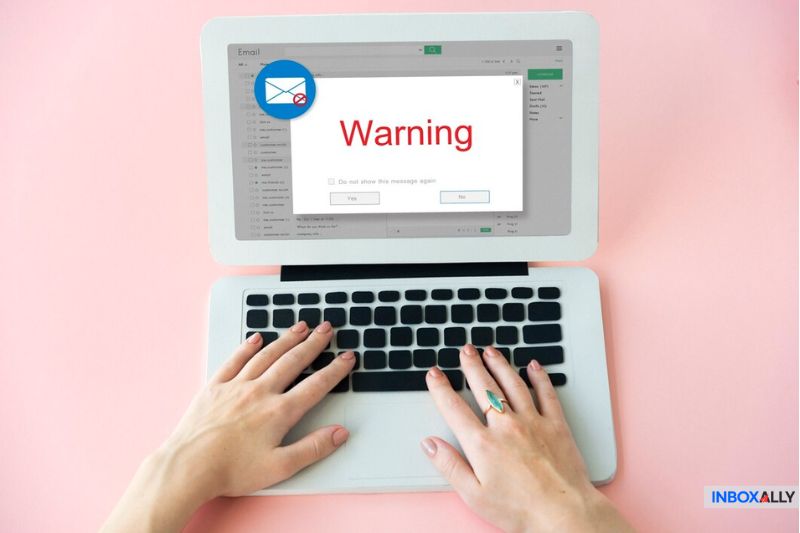As armadilhas de spam podem afetar gravemente a capacidade de entrega de e-mails, levando à inclusão de IPs na lista negra, à redução da reputação do remetente e ao posicionamento inferior na caixa de entrada.
Atingir uma armadilha de spam original é particularmente prejudicial em comparação com as recicladas, o que torna crucial para os profissionais de marketing por e-mail evitá-las proativamente.
Atualmente, as armadilhas de spam desempenham um papel importante na identificação de spammers. Os profissionais de marketing por e-mail, especialmente aqueles que enviam e-mails em massa, devem entender o que são armadilhas de spam e como evitá-las.
Este guia orientará você na detecção de armadilhas de spam, ajudando-o a manter uma lista de e-mails limpa e a evitar problemas graves de capacidade de entrega.
Sem a manutenção adequada e a limpeza regular, você pode, sem saber, ser sinalizado como spammer por alguns provedores de caixa de correio. Apenas uma armadilha de spam pode prejudicar sua capacidade de entrega, muitas vezes sem que você perceba.
Portanto, se você quiser descobrir ameaças ocultas que podem estar prejudicando silenciosamente a reputação do seu remetente, continue lendo…
O que são armadilhas de spam?
![]()
Também conhecido como honeypotsas armadilhas de spam são endereços de e-mail usados por provedores de caixas de correio, incluindo operadores de listas negras, clientes de e-mail e provedores de serviços de Internet (ISPs), para identificar remetentes de e-mails de spam.
Esses endereços podem ser recém-criados exclusivamente para capturar spammers ou contas de e-mail mais antigas e abandonadas, reaproveitadas para a mesma finalidade.
Além disso, os endereços de e-mail de armadilhas de spam nunca ficam visíveis publicamente ou são publicados em sites para evitar que remetentes legítimos os encontrem acidentalmente.
As armadilhas de spam são gerenciadas por várias organizações, incluindo DNSBLs (Domain Name System Blacklists) como Spamhaus, Spamcop e Barracuda. Essas entidades usam traps para identificar remetentes com higiene de lista ruim.
Os principais provedores de e-mail, como Gmail, Yahoo e AOL, também mantêm armadilhas de spam, e se você for atingido por uma delas, poderá ser colocado permanentemente na lista negra.
Seus e-mails devem ser vistos pelo seu público, e não ficar na pasta de spam. Se as armadilhas de spam estiverem prejudicando a reputação do seu remetente, o InboxAlly pode ajudar você a recuperar e otimizar o posicionamento na caixa de entrada. Veja-o em ação – agende uma demonstração.
Tipos de armadilhas de spam
As armadilhas de spam vêm em diferentes formas, e cada uma delas pode capturar remetentes que usam práticas inadequadas de gerenciamento de listas. Algumas são feitas especificamente para detectar spammers, enquanto outras são mais simples, originadas de endereços de e-mail desatualizados ou com erros de digitação. Entender essas variações pode ajudar você a evitar cair em uma delas e manter uma lista de e-mails limpa.
Armadilhas de spam puras (pristinas)
As armadilhas de spam puras, também conhecidas como armadilhas de spam pristinas, são endereços de e-mail criados por ISPs e outras organizações especificamente para capturar spammers. Esses e-mails nunca foram usados por ninguém.
Então, como eles acabam em uma lista de assinantes?
Elas estão embutidas em sites e, quando os profissionais de marketing extraem sites ou compram listas, essas armadilhas são adicionadas sem que você saiba. Se você acertar uma armadilha de spam original, poderá entrar imediatamente na lista negra.
Armadilhas de spam semeadas
As armadilhas de spam semeadas são propositalmente ocultas em códigos-fonte de sites ou recursos on-line. Essas armadilhas identificam os profissionais de marketing que adquirem e-mails por meio de raspagem ou compra de listas não verificadas.
Armadilhas de spam recicladas
As armadilhas de spam recicladas são endereços de e-mail anteriormente válidos que foram abandonados e posteriormente reaproveitados pelos provedores como armadilhas. Mesmo que sua lista tenha sido obtida legalmente, o envio para esses endereços indica falta de higiene de e-mail e pode prejudicar a capacidade de entrega.
Armadilhas de spam de erro de digitação
Às vezes, as pessoas digitam incorretamente seus endereços de e-mail durante a inscrição, o que leva a variações como “yaho” em vez de “yahoo” ou “gnail” em vez de “gmail”. Esses erros, aparentemente inofensivos, podem funcionar como armadilhas de spam, sinalizando remetentes que não limpam suas listas adequadamente.
Por que as armadilhas de spam são perigosas
Digamos que sua lista contenha uma armadilha de spam – o que acontece depois? Na pior das hipóteses, uma organização de segurança ou um provedor de serviços de Internet poderia bloquear o IP de onde seus e-mails estão sendo enviados.
“Mas será que não posso simplesmente aumentar minha lista de assinantes e eliminar as armadilhas de spam? Uma armadilha de spam em uma lista de 5 milhões de e-mails não é um grande problema, “Infelizmente, os ISPs e as organizações que gerenciam as armadilhas de spam não veem as coisas dessa forma. Eles não se importam se você está enviando para 5 ou 5 milhões de destinatários, pois o fatode você ter sido atingidopor uma armadilha de spam ainda pode prejudicar sua reputação.
Outras consequências das armadilhas de spam incluem:
- Lista negra permanente de seu IP ou domínio de envio
- Capacidade de entrega e posicionamento na caixa de entrada severamente reduzidos
- Taxas de rejeição mais altas e campanhas de e-mail fracassadas
É por isso que os profissionais de marketing por e-mail devem fazer da detecção de armadilhas de spam e da higiene da lista uma prioridade máxima.
Como detectar armadilhas de spam
Detectar armadilhas de spam não é fácil porque, à primeira vista, elas se parecem com qualquer outro endereço de e-mail. Você pode enviar e-mails para eles sem nenhum problema imediato. No entanto, há algumas técnicas que você pode usar.
Um dos métodos mais eficazes é acompanhar o envolvimento do usuário em todas as suas campanhas de e-mail. Como as armadilhas de spam não estão vinculadas a usuários reais, elas nunca abrem e-mails, clicam em links ou se envolvem de alguma forma.
Se você observar determinados endereços de e-mail que permanecem completamente inativos, eles podem ser armadilhas de spam ou, no mínimo, destinatários desinteressados. De qualquer forma, é melhor que você os coloque em uma lista negra ou os remova de sua lista.
Aqui estão mais algumas técnicas que você pode usar para identificá-los:
- Erros de digitação em endereços de e-mail – Se você encontrar endereços de e-mail com erros óbvios de digitação, remova-os imediatamente. Por exemplo, você pode encontrar test@gmial.com em vez de test@gmail.com.
- Endereços de e-mail falsos ou irrelevantes – Fique atento a endereços de e-mail duvidosos. Você acha que algo como zzmoms@nobodyserve.ter parece legítimo? Os provedores de e-mail criam esses endereços como armadilhas para capturar remetentes com pouca higiene na lista.
- Hard Bounces – É provável que você receba um hard bounce sempre que enviar um e-mail para uma armadilha de spam. Quando isso acontecer imediatamente, você poderá classificar esse endereço de e-mail como uma armadilha de spam e se livrar dele.
- Endereços inativos – Você ainda usa o primeiro endereço de e-mail que criou? Muitos endereços antigos e abandonados são reaproveitados como armadilhas de spam. Muitas vezes, eles podem ser identificados pelo monitoramento do envolvimento do usuário.
Mesmo que você remova as armadilhas de spam, o baixo envolvimento ainda pode prejudicar a capacidade de entrega. O InboxAlly pode ajudar você a obter melhores taxas de caixa de entrada e ficar longe do spam para sempre. Experimente você mesmo – reserve uma demonstração ao vivo hoje mesmo.
Como evitar endereços de e-mail de armadilha de spam
1. Use a confirmação de opt-in duplo
A melhor maneira de garantir uma lista de e-mails limpa é usar a confirmação de opt-in duplo durante a inscrição. Isso garante que somente endereços de e-mail válidos sejam adicionados à sua lista e confirma que os assinantes estão genuinamente interessados em receber seus e-mails.
2. Faça sua faxina de primavera (e outono, e verão…)
A limpeza regular da lista ajuda a eliminar as armadilhas de spam antes que elas causem problemas. Ao manter uma lista de contatos saudável, você pode remover e-mails desatualizados e endereços com erros de digitação.
Designar um ou dois membros da equipe para supervisionar esse processo garante que ele não seja negligenciado. A limpeza pode ser feita duas vezes por ano, trimestralmente ou sempre que for mais adequado ao seu fluxo de trabalho.
Mas essa é apenas uma peça do quebra-cabeça. O InboxAlly treina as caixas de entrada para que confiem em seus e-mails, melhorando o envolvimento e fortalecendo a reputação do remetente. Experimente o InboxAlly e combine as práticas recomendadas com uma ferramenta de capacidade de entrega ainda melhor!
3. Use ferramentas de verificação de e-mail
As ferramentas de verificação de e-mail , como a da InboxAlly, ajudam você a validar os endereços antes que eles entrem na sua lista, o que reduz as taxas de rejeição e melhora a capacidade geral de entrega.
Algumas ferramentas exigem que você carregue um arquivo CSV para uma limpeza única, enquanto outras oferecem monitoramento contínuo. Isso também permite que você filtre endereços inválidos com opções de lista negra e lista branca.
4. Segmentar seu público
Outra maneira de evitar armadilhas de spam é segmentar seus assinantes com base na atividade recente deles. De preferência, os usuários que receberam seu e-mail e abriram ou clicaram nele nos últimos 0 a 12 meses podem fazer parte de suas implantações de marketing para reduzir a probabilidade de atingir e-mails que são convertidos em armadilhas de spam.
5. Monitore atentamente a atividade do usuário
Os endereços de armadilhas de spam são configurados para receber um e-mail, mas não para interagir com ele. É por isso que incentivamos você a monitorar de perto a atividade da sua lista. Se um usuário parar de abrir seu e-mail ou de clicar em um link do seu conteúdo por vários meses, talvez você deva considerar a possibilidade de retirar essa lista de outras correspondências.
6. Aumente sua lista de forma orgânica
Embora a compra de listas de e-mail possa parecer uma solução rápida, aumentar sua lista organicamente é sempre a abordagem mais segura e eficaz.
O envio de e-mails para pessoas que realmente os solicitaram reduz significativamente o risco de armadilhas de spam e aumenta o envolvimento.
A melhor maneira de atrair assinantes genuínos é por meio de conteúdo de alta qualidade, promoção nas mídias sociais e adição de caixas de seleção de opt-in aos seus formulários de contato ou de conversão.
Ganhe o jogo de gato e rato
Você não é um spammer, mas ainda precisa ficar à frente no jogo contínuo entre ISPs e spammers.
Não ignore um alerta de armadilha de spam – se um deles for parar na sua lista, é um sinal claro de que ela precisa ser limpa. E se isso por si só não for suficiente, as estratégias que abordamos ajudarão você a corrigir o problema.
O processo pode levar alguns dias ou até mesmo algumas semanas, mas se você estiver disposto a se esforçar, poderá se recuperar dos danos ou – melhor ainda – evitar totalmente as armadilhas de spam mantendo-se proativo.
Afinal de contas, as armadilhas de spam só podem pegá-lo desprevenido se você permitir.
E se você precisar de ajuda, não tenha medo de entrar em contato! Na InboxAlly, ajudamos inúmeros clientes a evitar as armadilhas de spam e a melhorar a capacidade de entrega de seus e-mails. Você quer ver como? Agende uma demonstração ao vivo conosco hoje mesmo.


